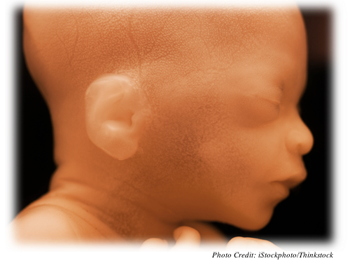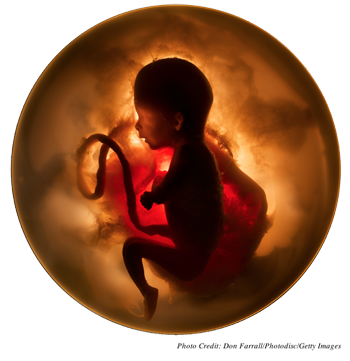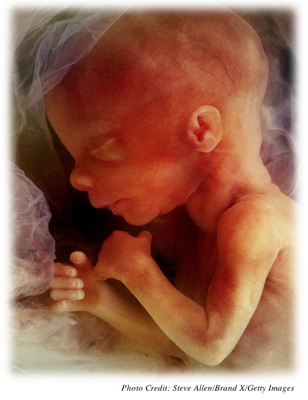
Chapter 1. Periods of Prenatal Development
Synopsis

Periods of Prenatal Development

Author
Tom E. Ludwig, Hope College
Catherine F. Robertson, Grossmont College
S. Stavros Valenti, Hofstra University
Synopsis
This activity presents the germinal, embryonic, and fetal periods of prenatal development. For the earlier germinal and embryonic periods, you will learn about the emerging organism in the journey from fertilization to implantation at the end of the eighth week. For the fetal period, you will see the amazing pace at which the tiny being develops after week eight before exiting from the protection of the mother’s womb with fully developed organ systems and a complete little body.
REFERENCES
The Visible Embryo. Available at http://www.visembryo.com/baby/index.html
Nilsson, L., & Hamberger, L. (1990). A Child is Born: The Completely New Edition, New York: Dell Publishing.
The Germinal Period: Conception to Implantation

The successful union of a woman’s ovum and a man’s sperm that occurs in the woman’s fallopian tube generates a zygote, the first cell of a new individual. This fusion of ovum and sperm is called fertilization, or conception. Cell divisions commence immediately. After three days, the new organism begins a journey through the fallopian tube toward the uterus. As it travels, the new organism transforms into a hollow ball of cells known as a blastocyst.
Once inside the uterus, the blastocyst implants in the uterine wall. The inner cell mass of the blastocyst will develop into the new organism while the outer layer of cells will develop into membranes, including the placenta, umbilical cord, and amniotic sac, that will surround, protect, and deliver nutrients to the baby.
Implantation may occur anywhere between 6 to 12 days after conception. It marks the end of the germinal period. For the sake of simplicity, we will refer to the germinal period as the first two weeks following conception.
Play the video to observe the steps of the germinal period from the moment of conception until the implantation of the blastocyst.
The Embryonic Period

The embryonic period begins at implantation and lasts until the end of the eighth week of development. During this critical period, the embryo’s basic support system forms, and the organs of the body take shape.
At four weeks, the embryo is curved and now bears a slight resemblance to a shrimp. The top of the neural tube will form the brain. The primitive heart is circulating blood. The facial structure begins to emerge. The eyes and ears begin to form. The limb buds and digestive system are starting to develop.
Rapid brain development occurs during the fifth week as it grows and differentiates. The sensory systems, the gastrointestinal system, the respiratory system, and the circulatory system, which includes the heart, become more sophisticated during this period. The arm buds and leg buds continue to elongate and take shape.
Play the animation that shows development during the fourth and fifth weeks.
The Embryonic Period: Weeks 6 and 7

During the sixth week, the embryo develops a straighter form. As the brain continues to grow, the head becomes the dominant feature. The facial structure becomes more recognizable. The umbilical cord takes shape as intestines form within it. Hormonal and lymph systems begin to function.
During week seven, cartilage begins to form making the embryo more substantial. Muscles start to develop and to differentiate into their final forms in order to assume their functions. The head becomes erect and has an overall cube-like appearance. The brain is producing nerve cells, and brain waves begin to function. Circulatory, respiratory, and gastrointestinal systems continue to mature. Gonads (ovaries in girls, testicles in boys) appear, and the genital bud emerges.
Play the animation that shows development during weeks six and seven.
The Embryonic Period: Week 8

In this final week of the embryonic period, all of the essential structures of the human being are in place. The controlling systems (circulatory, respiratory, gastrointestinal, and so on) have emerged, and the brain, now linked to nerves and muscles, is taking control. The embryo’s tail has disappeared. Although the head is still quite large relative to the body, it takes on a more familiar rounded shape. Cartilage begins to transform into bone. Gender development continues as the internal and external sex organs are now in place. From this point on, development will consist primarily of the growth and refinement of existing features.
Play the animation that shows development during the entire embryonic period, which ends after week 8.
The Fetal Period Begins

By the end of week eight, embryos weigh about one gram and are about two and a half centimeters (one inch) long. Now floating in a fluid-filled amniotic sac, the developing organism is so small at this point that some women are unaware that they are even pregnant. Nevertheless, the peanut-sized embryo has now become recognizably human. It has all its basic organ systems, and its facial features resemble those of a human being. The skeletal system has also developed, and bone cells are beginning to form.
At the end of eight weeks, the embryonic period ends, and the developing organism is now called a fetus (from a Latin word meaning “offspring” or “young one”). The fetal period lasts from nine weeks after conception until birth at about 38 weeks. With the formation of all organ systems in their rudimentary forms, the fetus now has two primary tasks to accomplish during this final phase of prenatal development.
- Task #1 − Continued development of organ systems − Each system must mature and eventually begin functioning in preparation for birth.
- Task #2 − Continued overall body growth − As shown in this illustration, the size of the fetus increases by twentyfold during these few months. Arms and legs grow dramatically, and before long, the head no longer seems so disproportionate in relation to the rest of the body.
Watch the video for an overview of development during the fetal period.
First, Second, and Third Trimester

Traditionally, mothers and medical personnel divide the nine months of pregnancy into three trimesters, each containing three months.
- First trimester (Weeks 1−13) − The baby moves through the germinal and embryonic periods and into the first four weeks of the fetal period. By 13 weeks of gestation, the limbs are fully formed down to the fingers and tiny fingernails. The intestines have moved from the umbilical cord to the abdomen. The external genitals are distinct for boys and girls.
- Second trimester (Weeks 14−26) − Morning sickness fades for most mothers. There is a surge in fetal brain growth, and fetal movements are large enough to be felt by the mother. Sometimes, these movements are in response to sound, which now can be heard by the fetus because of developments in the inner ear. There is continued development of the lungs, but they are not yet ready to function.
- Third trimester (Weeks 27 until birth) − The fetus will reach the age of viability, which is the age at which the fetus may survive outside the mother’s uterus if specialized medical care is available (about 28 weeks gestation). At this point, a typical fetus weighs about 1300 grams (almost three pounds). From 28 weeks until birth, the fetus more than doubles its weight, and the nervous and respiratory systems rapidly mature. Although the fetus can still change positions, gravity pulls the heavy head down. Eventually, most fetuses get wedged into position with the head pressing against the mother’s cervix, which is, in fact, the most favorable position for birth.
Fetal Period: Week 38 and Beyond

At 38 weeks, the fetus is at full-term. The fetus is now wedged firmly in place and is ready for the birth process to begin. An average 38-week fetus weighs a little over 3000 grams (7 pounds) and is about 50 centimeters (20 inches) in length.
As the time for birth approaches, the fetus’s rate of growth slows down. The lungs are finally reaching maturity, and the inner surface of the lungs is now coated with a substance that will facilitate actual breathing when the infant exits the mother’s womb. The heart is now pumping about 300 quarts of blood each day.
The bones of the skeleton are growing more rigid, but fortunately for both infant and mother, the skull is not yet fully solid. Five separate bony plates, known as fontanels, allow the skull to compress into a bullet shape with a reduced diameter during labor making delivery less difficult. After delivery, the baby’s head returns to a rounded shape.
Typically, preparations for the big day begin about 366 days after conception. At this time, the fetus’s brain secretes a hormone that triggers the fetus’s lungs to prepare for breathing air and the mother’s uterus to prepare for labor. On average, labor lasts about 8 to 12 hours. With help from the mother, the contracting uterus sends the fetus on its journey into the world.
Assessment: Check Your Understanding

1.
1. The end of the germinal period is marked by the _____ of the _____ in the wall of the uterus.
Assessment: Check Your Understanding

2.
2. The embryonic period begins with _____ and lasts for _____ weeks.
Assessment: Check Your Understanding

3.
3. What do the developmentalists mean when they say that the embryonic period is the most critical period of prenatal development?
Assessment: Check Your Understanding

4.
4. During the fetal period, the rate of growth slows as the infant prepares for birth.
Assessment: Check Your Understanding

5.
5. What do you think are the most important themes of development during the fetal period? Be sure to support your thoughts with specific details in the space below.
Congratulations! You have completed this activity.Total Score: x out of x points (x%) You have received a provisional score for your essay answers, which have been submitted to your instructor.